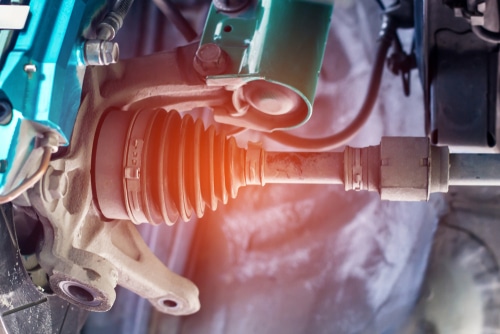Quick Answer Table
| Vehicle Type | Number of Axles |
|---|---|
| Passenger Cars | 2 axles |
| Trucks/SUVs | 2 axles |
| Semitrucks, Machinery | Often have 5 axles or more |
Each axle can have one or two wheels attached to it, so a typical car with two axles would have four wheels.
The number of axles in a vehicle influences its ability to carry weight, maneuver, and distribute the load effectively.
What is a Car Axle, And What Does it Do?

A car axle is a central component of your vehicle’s wheel system. It primarily serves two purposes: to bear the weight of your vehicle and to help drive your car forward.
Axles are crucial for steering, driving, and braking, essentially ensuring your car’s wheels remain in consistent alignment and performance.
There are different types of axles, each designed for specific functions:
- Front Axle: Supports the front of the car and contributes to steering and absorbing shocks from the uneven road surface.
- Rear Axle: Connects the rear wheels. It also bears the weight of the cargo and the back end of the car.
Types of Car Axles:
- Live Axle: Powers the wheel.
- Dead Axle: Does not transfer power.
- Tandem Axle: A pair of axles situated close together.
Your car’s power is transmitted from the engine to the wheels using the axle.
In front-wheel-drive cars, the front axle is connected to the transmission, while in rear-wheel-drive cars, the rear axle is connected.
The axle ensures the wheels rotate with the body of the car on turns and helps disperse energy from the road surface through the suspension system.
Understanding your axle’s condition and maintenance needs can prevent vehicle malfunctions.
Standard Axle Count in Cars

When discussing the typical number of axles in cars, most passenger vehicles—including sedans, hatchbacks, and small SUVs—have two axles.
One axle is found at the front of the vehicle, while the other is located at the rear. Each axle is essential for mounting the wheels, providing stability, and enabling the vehicle to drive.
In contrast, larger vehicles such as full-sized SUVs, trucks, or vans may have more than two axles. These are designed to support additional weight and improve performance under heavier loads.
Here’s a simple outline:
- Compact Cars, Sedans, Hatchbacks, Small SUVs:
- Typically, 2 axles
- Front Axle: Steering and often bears the engine’s weight
- Rear Axle: Drivetrain and load-bearing
- Typically, 2 axles
- Large SUVs, Trucks, Vans:
- Can have more than 2 axles
- Extra axles aid in weight distribution and stability
Your vehicle’s specific axle count can usually be confirmed by referring to your owner’s manual or by a visual inspection.
Keep in mind that specialized or customized vehicles could have non-standard axle configurations.
Factors Influencing Axle Numbers
When considering the number of axles on a vehicle, a few key factors come into play.
For a typical car, you’ll find that the design and intended use are the primary determinants.
- Vehicle Type & Purpose:
- Passenger Cars: Generally have two axles.
- Commercial Vehicles: May have more than two axles to support heavy loads.
- Size & Weight:
- Larger and heavier vehicles require additional axles for support.
- Performance:
- High-performance cars may have a different axle configuration for better handling.
- Traction Needs:
- Vehicles designed for off-road or all-weather conditions might have more axles for improved traction.
- Legal Restrictions:
- Regulations may limit the number of axles due to road wear or bridge stress concerns.
- Engine Location:
- Rear-engine cars might differ in axle construction compared to front-engine cars.
The table below summarizes typical axle arrangements based on vehicle type:
| Vehicle Type | Typical Axle Number |
|---|---|
| Standard car | 2 |
| Pickup truck | 2 |
| Semi-truck | 3 to 5 |
| Heavy machinery | 4 or more |
Remember, your car’s axle count directly relates to these factors.
Always refer to the manufacturer’s specifications for the exact number of axles on your vehicle.
Types of Axles in Automobiles
Axles are key components in your vehicle, transferring power from the engine to the wheels and supporting the weight of your car.
Front Axles
Front axles are found at the front of your vehicle and are responsible for assisting in steering and processing the shock from the uneven surface of the road.
They are typically made of strong steel to withstand the force and stress exerted during driving.
Depending on your car’s drivetrain, front axles may also transmit power to the front wheels.
- Composition: Forged or heat-treated steel
- Function: Steering, shock absorption, power transfer in FWD vehicles
Rear Axles
Your car’s rear axles are located at the back and are essential in delivering power from the engine to the rear wheels in rear-wheel-drive (RWD) vehicles.
They have different configurations such as the full-floating, semi-floating, or three-quarter floating types, designed to support vehicles’ weight and rotational force.
- Configurations: Full-floating, Semi-floating, Three-quarter floating
- Function: Power transmission in RWD and AWD vehicles, support vehicle weight
Inter-Axle Differential
The inter-axle differential is important if your vehicle is equipped with an all-wheel-drive (AWD) or four-wheel-drive (4WD) system.
It allows for different wheel speeds between the front and rear axles, providing better traction and handling on various surfaces.
- Purpose: Allows different wheel speeds, improves traction
- Useful for: AWD and 4WD systems
Axle Configurations by Vehicle Type
Axle configurations vary according to the design and purpose of the vehicle. Understanding the specific setup of your vehicle facilitates better maintenance and informed purchase decisions.
Sedans and Coupes
Most sedans and coupes are equipped with two axles: one at the front and one at the rear.
The front axle typically manages steering and, in many cases, power transmission (for front-wheel-drive vehicles) while the rear axle is usually where the suspension components are located.
- Front-wheel drive: 1 front axle (powered), 1 rear axle (non-powered)
- Rear-wheel drive: 1 front axle (steering), 1 rear axle (powered)
- All-wheel drive: 1 front axle (powered), 1 rear axle (powered)
SUVs and Trucks
SUVs and trucks can have two to three axles depending on their size, capability, and whether they’re intended for consumer or commercial use.
- Standard SUVs and light trucks: 2 axles (similar to sedans but built to withstand greater load)
- Dual rear wheel trucks (dually): 3 axles (one at the front, two at the rear) for heavy-duty performance
Specialty Vehicles
Specialty vehicles, such as limousines or certain recreational vehicles (RVs), have customized axle configurations to support their unique design and weight distribution needs.
- Limousines: 2 to 3 axles depending on length and custom requirements
- Large RVs: Up to 3 axles to support the weight of the living quarters and amenities, and to provide stability and a smoother ride.
